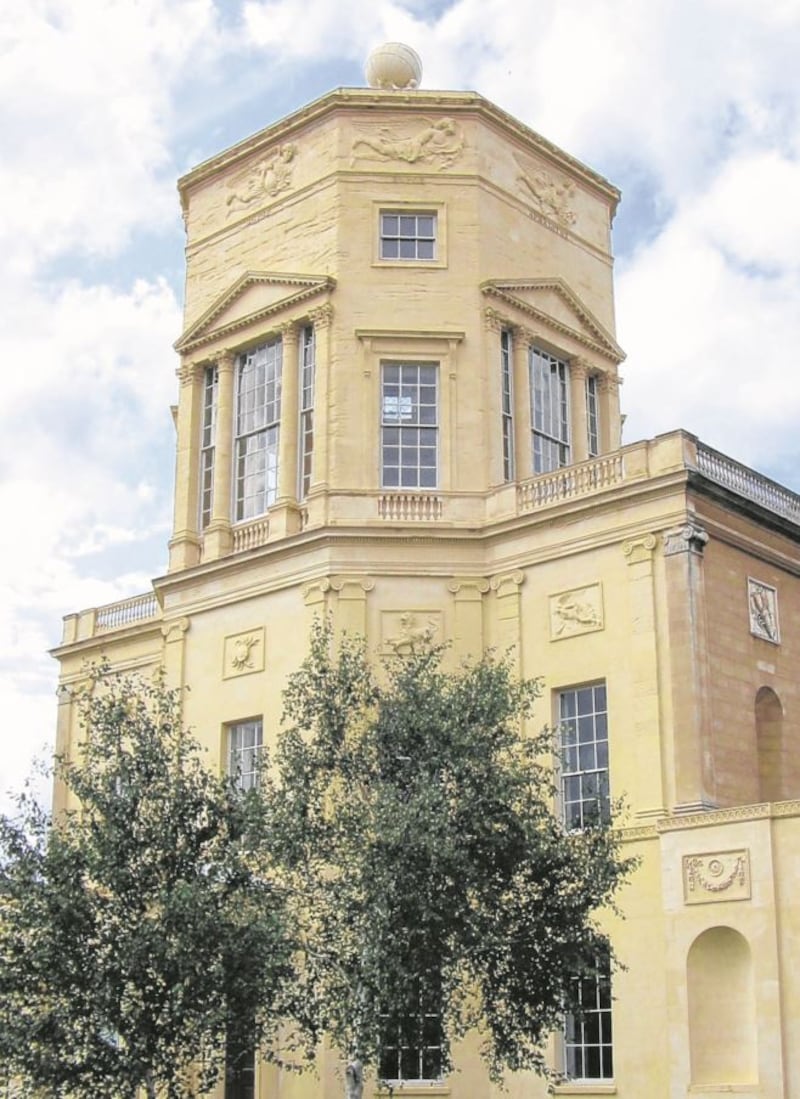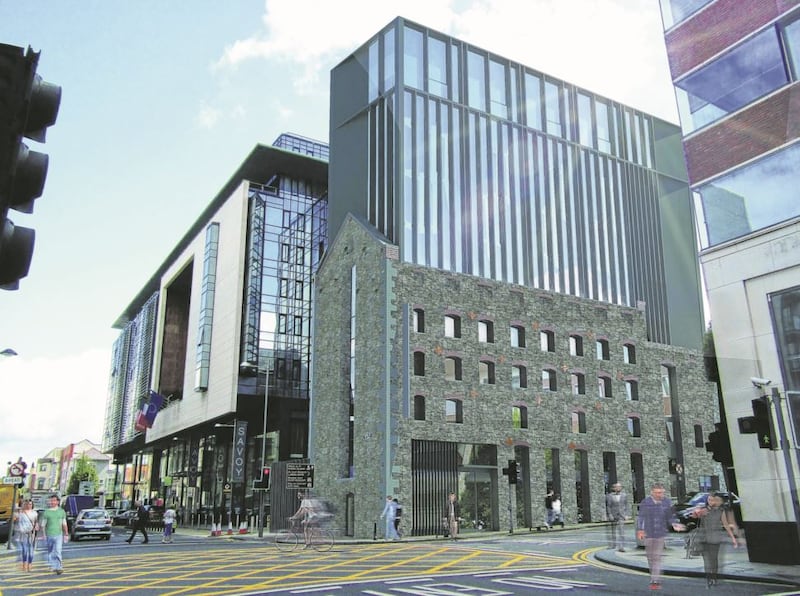When the Clarion Hotel rose above Limerick’s Steamboat Quay in 2002, nearly everyone thought that the city had finally “arrived”. With a height of 53m – shorter than Dublin’s Liberty Hall – Murray O’Laoire’s elliptical 17-storey hotel tower became the most photographed architectural statement on the river Shannon after King John’s Castle.
Three years after the Clarion was completed, Limerick aimed for the sky again with BKD’s Riverpoint, a 15-storey office block with blue mirror-glazing that stands like a sentinel on the city side of Shannon Bridge. At 58.5m it is even taller than the hotel and flanked by two blocks of apartments, adding more life to a rapidly rejuvenated riverfront.
Soon visitors to Limerick will have three more towers to photograph, assuming that planning permission is secured for schemes in the pipeline: an interactive visitor centre celebrating the city’s rich rugby heritage, a 15-storey tower on Bishop’s Quay, behind Henry Street, and a third on the so-called Opera Site at Bank Place/Patrick Street.
The Bishop's Quay tower, designed by Limerick architects Michael Healy and Partners for Kirkland Investments, has already got planning permission despite an appeal by the Irish Georgian Society to An Bord Pleanála. With a flanking seven-storey block of apartments, the €40 million scheme is backed by former Lord of the Dance Michael Flatley.
Its office tower, rising to a height of almost 60m, would have a predominantly glazed façade with a "rhythmic patten of aluminium solar shading panels", according to project architect Elaine Bowe. "The prominent site is a fantastic location for a tall building representative of its time and responsive to its waterfront and city location."
The 14-storey tower proposed for Bank Place, near the old Custom House (now occupied by the Hunt Museum), is a notional element of the design brief issued last by Limerick City and County Council for the so-called Opera Site, a largely “brownfield” urban block on the northern edge of the city centre, which is to be renovated mainly for offices.
According to the council’s brief, the site presents an “opportunity for a tall building . . . addressing the Abbey River at Bank Place”, as a new city landmark. Indeed, this was first canvassed by Limerick 2030, an economic and spatial strategy published in 2013, which pledged that there would be a “world-class riverfront” along the Shannon by 2030.
Georgian core
Of the three towers the one with the most serious architectural intent is the International Rugby Experience planned for O’Connell Street in the city’s still forlorn Georgian core of Newtown Pery. It has been designed by Dublin-born Niall McLaughlin, who is among the most talented of contemporary Irish architects, albeit based in London.
With numerous garlands to his credit, including the Royal Institute of British Architects’ Charles Jencks Award for making “a major contribution internationally to both the theory and practice of architecture”, McLaughlin is renowned for turning every commission into a bespoke project that delivers considerably more than his clients might expect.
The planned rugby extravaganza for Limerick is being overseen by an advisory board headed by former Munster, Ireland and Lions captain Paul O'Connell, while bookmaker and racehorse owner JP McManus has pledged €10 million for the project, saying that the sport of rugby "is at the core of Limerick" and would now be contributing to its regeneration.
What’s proposed for the site of three Georgian buildings at 40-42 O’Connell Street is an entirely new edifice (bar the retention of Fines Jewellers shop at the corner of Cecil Street), with a setback tower rising several floors above its existing parapet line. And it’s this element of the scheme which has raised the hackles of conservationists, including An Taisce.

Roman in its inspiration and scale, with the tallest arches right on top, it speaks of the Caracalla Baths, and consists of three elements: a deep proscenium-like portico leading into a double-height entrance foyer, three storeys of exhibition space improbably raised over the immovable jewellers, and a 32-metre tower with panoramic views.
Fantasy design
Images of the scheme provoked outrage on social media. “That’s bonkers! Completely over-scaled,” Daragh Boyce tweeted. “I’m struggling to see the relevance of that weird set-back tower. It’s like an indulgent fantasy design wedged into a real Georgian street.” Historian Dr Paul O’Brien saw it as “another nail in the coffin of Georgian Limerick”.
But McLaughlin defends his design. “I’m not sure why height is [seen as] so un-Georgian,” he said. “Many, if not most, of their public edifices soared unapologetically above the parapet datum of surrounding houses. It marked their civic status and broke the sometimes unrelenting monotony of streetscape imposed by the Georgian terraces.”
Referring to a recent visit to Oxford, he recalled how we had stood outside Worcester College, looking north along Walton Street, and admired the way that the street “frames the view of the fabulous Radcliffe Observatory tower, built by Keane and Wyatt to observe the transit of Venus in 1769. It is one of Oxford’s Georgian masterpieces.”
McLaughlin cites several other examples of “gorgeous Georgian precedents” from Dublin, Edinburgh, Oxford and Philadelphia of public buildings from that era (or later) that were built significantly taller than their neighbours; his Dublin examples include Findlater’s Church on Parnell Square and the Peppercanister in Mount Street Crescent.
Long vista
The difference between these and what is planned for Limerick is that Findlater’s spire was built at the end of a Georgian terrace, while the Peppercanister is symmetrically positioned to close a long vista from the west side of Merrion Square. The proposed Rugby Experience tower is neither on a corner nor would it have any vista-stopping role.
But McLaughlin has a jaundiced view of Newtown Pery, arguing that it was developed as an “exclusive residential enclave far away from the plague-ridden medieval streets of Irishtown” in Limerick. Poor people were “positively discouraged” from going there. “The obsessive control of architectural decorum was matched only by rigid social control.”

In the 19th century, this hierarchy was only “leavened”, he believes, through “the introduction of new public buildings for the people. Most of these, in the spirit of the age, matched the national passion for church building [hence the ‘City of Spires’]. The interruption of consistent urban form was a manifestation of the democratisation of the area.”
He uses this thesis to justify the extra height of the Rugby Experience, saying: “I don’t think it is wrong to put a tall building onto this site if it has a truly public and popular purpose. It is an expression of a local, regional and national passion: the game of rugby. The top of the tower is not a crummy office or plant room. It is a grand public room for the city.”
Totally altered
As for the buildings to be demolished to make way for it all, McLaughlin says these could not be regarded a “high-quality protected stock”, with only “Georgian remnants”, interiors “gutted and totally altered”, and façades “irreversibly rendered” in cement. “Surely the indifferent old can sometimes make way for the new?” he suggests.
"Our building is not in the full flow of intact O'Connell Street, but at the commercial end, across the road from the bulky new AIB building and just over from the eight-storey George Hotel," he says, in reference to claims that it would be an "alien intrusion" into the Georgian core. "I think it will bring some distinction to an indifferent stretch of the street."
While welcoming a “cathedral for rugby” in principle, An Taisce expressed fears that it would create an “undesirable precedent” in an officially-designated Architectural Conservation Area (ACA) . It has appealed the case to An Bord Pleanála, arguing that the “considerable bulk and height” of its seven-storey tower would “undermine” the ACA designation.
Apartments
An Taisce has also appealed against Limerick City and County Council's approval for plans by Kirkland Investments to extend the Savoy Hotel on Henry Street by gobbling up a relatively rare 1790s cornstore alongside; derelict for years, the building was sensitively renovated for apartments in the "Celtic Tiger" era by Limerick-born developer Aidan Brooks.

Only the shell would be retained, with a 10-storey tower shooting up through it – an unwitting evocation of the birth scene in Alien. Yet project architect Elaine Bowe, of Michael Healy and Partners, prefers to define the proposed "vertical roof box", however improbably, as a contemporary version of the classical entablature – architrave, frieze and cornice.
Apart from the architectural treatment, which it says would “seriously compromise” the old cornstore’s heritage value, An Taisce complains that the scheme would involve sacrificing nine apartments to create 20 extra rooms for the Savoy Hotel; indeed, none of the latest batch of towers would contain a single square metre of residential accommodation.
No doubt there will be further proposals for more towers, especially along the Shannon riverfront, to fill in visual gaps between those already built or planned to achieve an equidistance between the high-rise elements of this new-look Limerick. Yet I can’t help thinking that the city would be better off rejuvenating Newtown Pery as a prime residential area.










